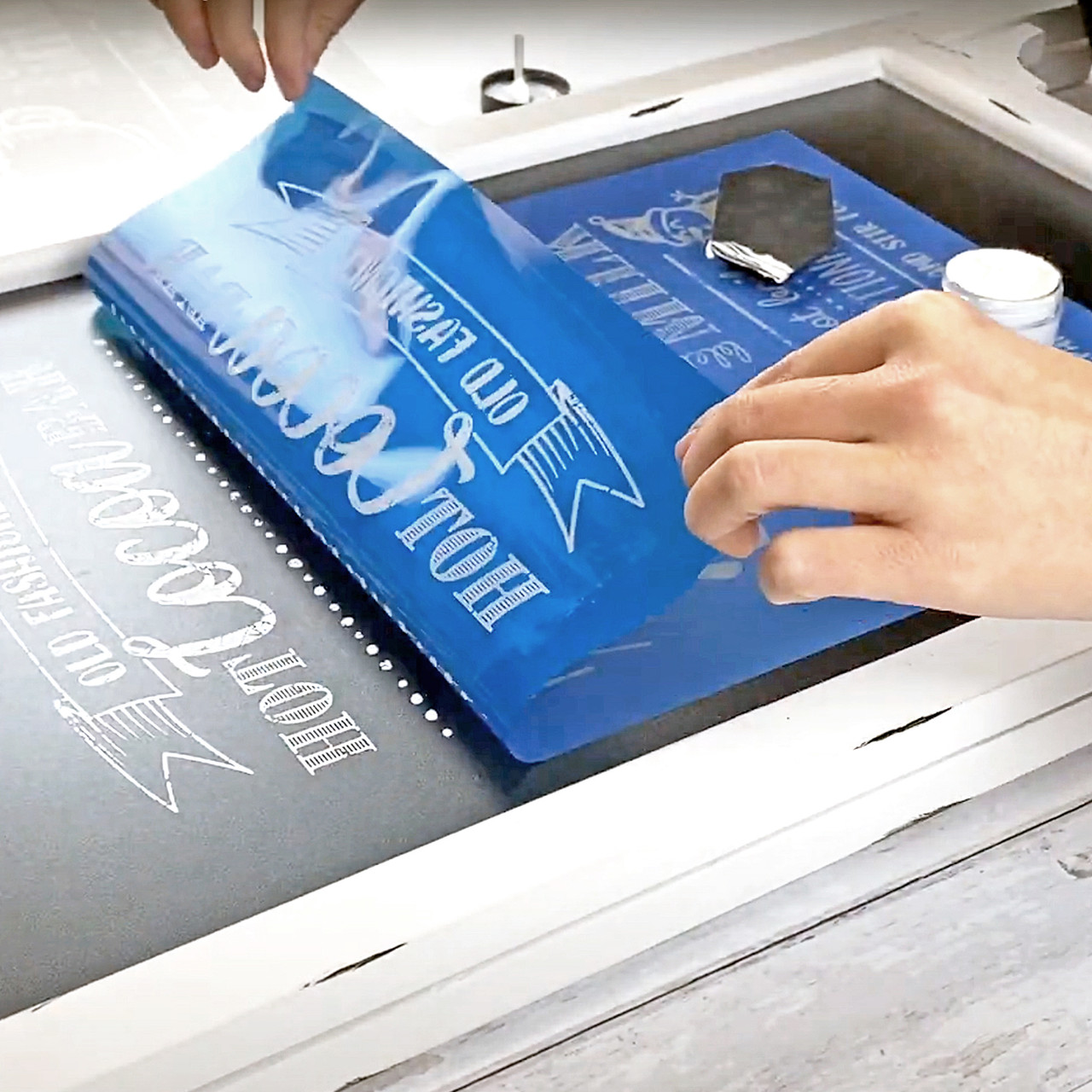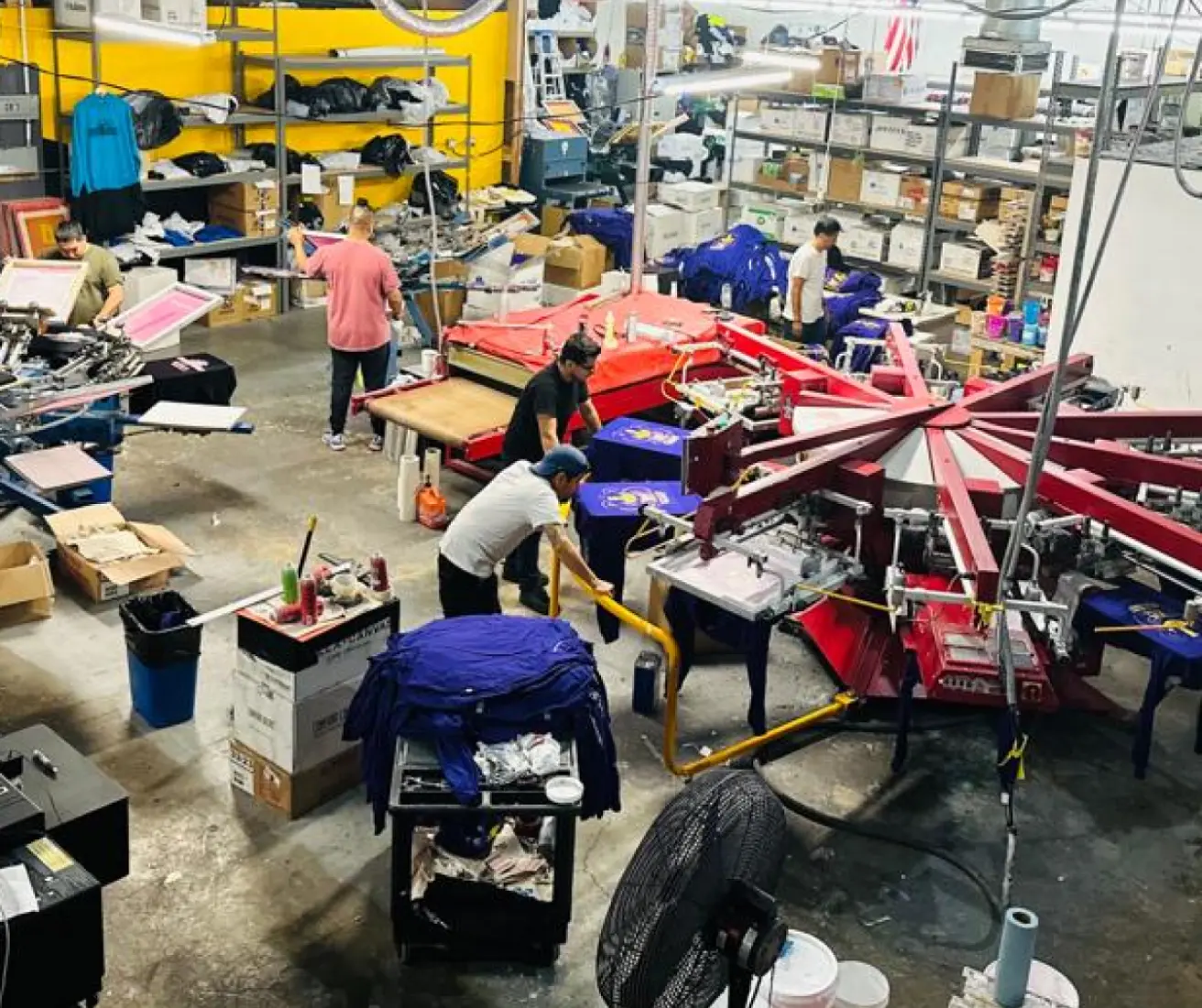High-End Silk Screen Printing for Premium Garments
High-End Silk Screen Printing for Premium Garments
Blog Article
Display Printing Uncovered: Everything You Need to Understand About Tee and Garment Printing Methods
Display printing is an interesting method that combines art with strategy, supplying limitless possibilities for creative thinking. Prepared to explore the vital elements that make screen publishing an art kind?
The Essentials of Screen Printing: Exactly How It Functions
When you plunge right into display printing, you'll discover it's both an art and a science. At its core, screen printing entails developing a pattern, or screen, that permits ink to go through just in specific areas (screen printing kit). You start by picking your design and preparing your display with a light-sensitive emulsion. As soon as you expose this emulsion to light, it sets, leaving your style as an adverse area.
Following, you'll mix your inks and prepare your printing surface. Setting the screen over the textile, then utilize a squeegee to push ink via the display onto the garment. This procedure calls for accuracy, as you desire clear, vivid prints. After printing, you'll heal the ink with warm, ensuring it abides by the material and lasts through laundries. Each step is important, and understanding them will raise your display printing skills, transforming basic garments into special, expressive pieces.
Kinds of Screen Printing Methods
As soon as you understand the essentials of screen printing, it's time to check out the different techniques that can raise your designs. One prominent technique is typical screen printing, where ink is pushed through a stenciled screen. This technique is excellent for vibrant, vibrant colors. There's water-based ink printing, which uses a softer feel and is environmentally friendly, however it needs a different approach to treating.
If you're going for fine details, think about discharge printing. This method gets rid of color from the fabric, leaving a soft, classic look. One more alternative is plastisol printing, known for its resilience and brilliant shades, making it a favorite for numerous brand names. Finally, explore halftone printing to create slope effects and elaborate styles. Each technique has its distinct appeal, so don't be reluctant to attempt them out to locate what fits your style best!
Essential Devices for Display Printing
To accomplish sensational lead to screen printing, having the ideal tools is fundamental. First, you'll require a durable display printing frame, which holds the mesh that transfers your layout onto the garment. Next off, spend in top quality squeegees; these are important for using ink equally throughout the screen. You'll likewise call for a good direct exposure unit to develop your screens, along with a washout cubicle for cleaning them after usage. A dependable warmth resource, like a conveyor dryer or warm press, is important for treating your prints to ensure durability. Don't forget a correct office, geared up with tables and storage for your products. Finally, protective equipment, such as masks and handwear covers, will maintain you safe from chemicals and inks. With the right devices, you'll be well on your way to creating professional-quality prints.
Picking the Right Inks and Materials
When picking inks and materials for display printing, you require to think about the sort of ink that functions ideal for your project. Think of textile compatibility to ensure your styles look last and wonderful long. Also, check out environment-friendly ink alternatives to make your printing process much more lasting.
Sorts Of Screen Inks
Selecting the best display ink is crucial for achieving dynamic, long lasting prints that satisfy your job's requirements. There are a number of types of screen inks to take a look at. Specialty inks, such as glow-in-the-dark or metallic, can include distinct impacts to your designs.

Textile Compatibility Considerations
Comprehending material compatibility is essential for attaining premium display prints, especially given that various products react distinctively to different inks. When choosing inks, consider the textile kind-- cotton, polyester, or blends. For cotton, water-based inks work well, offering soft qualities and breathability. Polyester, on the other hand, often requires plastisol inks for better adhesion and vibrant colors. You could need to use a mix of both types if you're publishing on blends. Always test your inks on sample textile to guarantee they adhere effectively and preserve color stability. Furthermore, bear in mind that fabric weight and appearance can affect the last end result, so choosing the appropriate ink and material combination is essential for your task's success.
Eco-Friendly Ink Options
Environmentally friendly inks are coming to be a prominent choice for screen printers that desire to reduce learn this here now their environmental impact while maintaining quality. When selecting inks, think about water-based inks, which are much less hazardous and less complicated to clean up compared to typical solvents.
Additionally, search for inks made from renewable energies, such as soy or vegetable-based options. By selecting the ideal inks and products, you'll not just produce stunning styles yet also add to a much more sustainable printing process. Make the switch, and your prints will show your commitment to the environment!
Preparing Your Style for Screen Printing

File Layout Requirements
To guarantee your layout looks dynamic and sharp on fabric, you'll require to pay close interest to submit style demands for display printing. Make sure your design has a transparent background to stop unwanted white sides on your prints. Keep color settings in mind; CMYK is basic for screen printing, so transform your RGB makes appropriately.
Color Separation Methods
Color separation is an essential action in preparing your style for screen printing, and mastering it can significantly enhance your print high quality. You'll need to damage your layout into private shades, as each shade needs a different display during printing. Beginning by determining all the colors in your design and produce layers for each one. You can use software program like Adobe Photoshop or Illustrator to separate and different shades successfully. Be specific to conserve each layer as a different documents, generally in a layout like TIFF or PSD. This accuracy not only ensures precise color depiction yet likewise streamlines the printing process. By focusing on shade splitting up, you'll achieve expert and lively cause your screen-printed garments.
Resolution and Size
Attaining the best results in display printing starts with assuring your design has the ideal resolution and dimension. Ideally, your artwork needs to go to least 300 DPI (dots per inch) for sharp, clear prints. If you use lower resolution, your end product may look amateur and pixelated.
When it comes to size, think about the measurements of your print area. Style your art work to match the last print dimension, preferably developing it in the actual measurements you'll be printing. In this manner, you'll prevent any kind of unforeseen scaling issues.
Constantly check your layout in both vector and raster styles. Vector graphics can be scaled without shedding high quality, making them suitable for screen printing. Preparing properly will guarantee your design looks impressive helpful resources on every garment!
Step-by-Step Display Printing Refine
Display printing is a vibrant process that enables you to develop dynamic layouts on various surface areas. To get started, learn the facts here now you'll require a display, solution, and your selected ink.
After rinsing the unexposed solution, your screen prepares. Establish it up on your printing surface and align your garment beneath it. Pour ink onto the display and utilize a squeegee to push the ink through the stencil onto the material. Raise the screen meticulously and allow the print completely dry. Cure the ink utilizing heat to ensure resilience. That's it! You have actually effectively screen printed your style.
Tips for Effective Display Printing Projects
While you're diving into your display printing tasks, keep in mind that prep work is crucial to success. Begin by collecting all your materials-- inks, mops, displays, and garments. A clean workspace helps stop unwanted mistakes, so clean up prior to you start.
Following, verify your artwork is high-resolution and effectively sized for your garment. Examine your display for appropriate exposure and tidy it completely to avoid spots. When mixing your inks, comply with the producer's guidelines to attain the ideal consistency.
Throughout printing, apply also pressure with your squeegee for consistent results. Do not rush; take your time to validate each print satisfies your standards. After printing, allow your garments dry totally before taking care of or packaging them.
Finally, constantly maintain an example of your work for future referral. In this manner, you can examine your development and boost your techniques over time. Pleased printing!

Regularly Asked Questions
Exactly how Lengthy Does It Take to Establish a Display Printing Job?
Establishing a display printing job generally takes about thirty minutes to an hour. You'll prepare the screens, mix inks, and readjust journalism. The time varies based upon intricacy and experience, so remain organized!
Can I Print on Different Fabric Enters Utilizing the Exact Same Strategy?
Yes, you can print on various textile types making use of the same strategy, but you'll require to adjust your inks and settings. Some materials take in ink differently, so trying out warranties the best results for each product.
What Prevail Errors to Avoid in Display Printing?
When screen printing, prevent typical mistakes like making use of the incorrect ink, overlooking appropriate exposure times, or missing pre-press checks. Always evaluate your configuration and preserve clean screens to guarantee top quality results each time.
How Can I Effectively Clean and Keep My Display Printing Equipment?
To properly tidy and preserve your display printing tools, you should routinely wash screens with proper solvents, check squeegees for wear, and assure all devices are saved dust-free and dry. Consistency enhances and stops expensive fixings performance.
Is Screen Printing Environmentally Friendly Compared to Other Methods?
Screen printing can be more environmentally pleasant than various other methods, especially if you make use of eco-conscious products and water-based inks. By selecting sustainable materials and techniques, you reduce waste and lessen your effect on the world.
Display Printing Uncovered: Whatever You Required to Know Concerning T-Shirt and Garment Printing Techniques
At its core, display printing includes developing a pattern, or display, that permits ink to pass with only in specific areas. Placement the screen over the textile, after that use a squeegee to push ink with the display onto the garment. One preferred method is conventional screen printing, where ink is pushed via a stenciled display.When selecting inks and materials for display printing, you require to take into account the kind of ink that functions best for your project.
Report this page